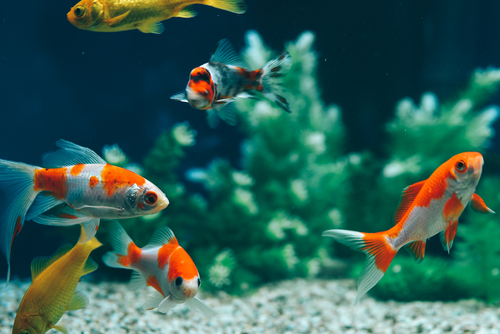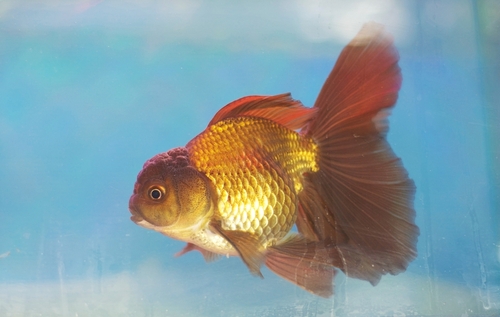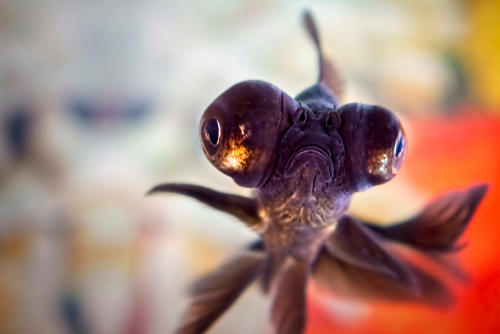Comet Goldfish Are Fast, Messy & Fun — Here’s Which Tank Mates Can Keep Up
When you purchase through links on our site, we may earn a commission. Here’s how it works.
Comet Goldfish are fast, social swimmers that thrive in cool, well-oxygenated water, but not every fish can keep up. Their playful energy and large size often overwhelm slower or tropical species, leading to stress and torn fins.
Before choosing a Comet Goldfish tank mate, you’ll need to match temperature, water parameters, and swimming style. Below, we break down what Comets need, the compatible species that share their pace, and which fish to avoid if you want a peaceful, balanced aquarium.
Table of Contents
Comet Goldfish Tank Mates – 4 Factors To Consider
Before choosing tank mates for your Comet Goldfish, it’s helpful to understand what makes this variety unique. These fish are larger, faster, and messier than most aquarium species, which means their environment needs to support both their size and activity level.
Get these four factors right — space, water quality, and companion compatibility — and your tank will thrive.
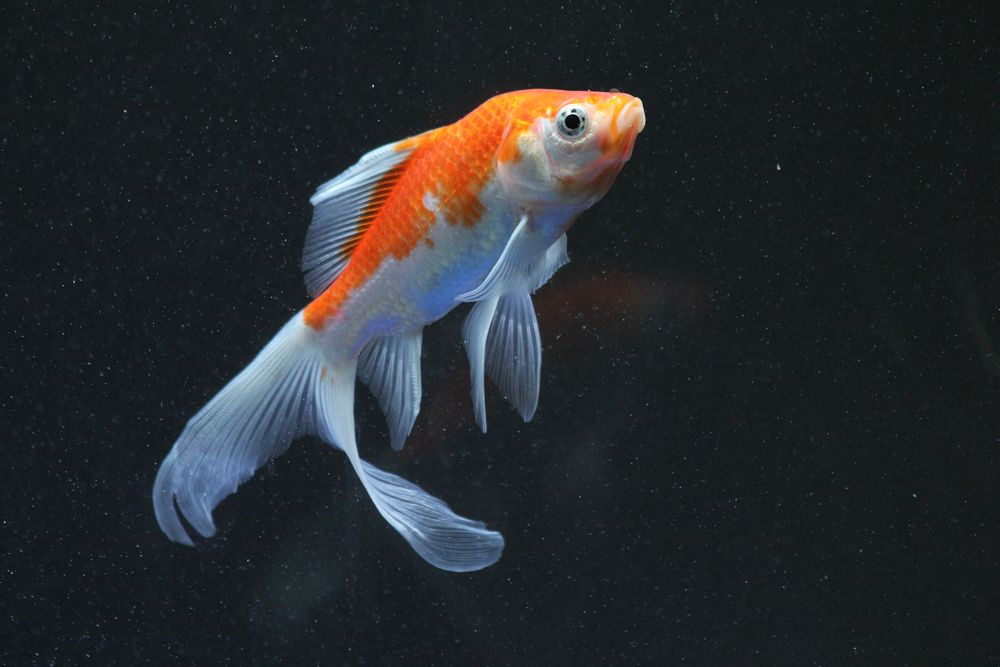
1. Temperament & Behavior
Comet Goldfish are active, curious, and surprisingly social. They’re constant swimmers that thrive in open water and mid-to-lower tank levels.
While peaceful, their high energy can overwhelm slower or delicate fish, especially during feeding.
Because Comets tend to eat anything that fits in their mouth, choose tank mates that are quick enough to dodge them and large enough not to be mistaken for food.
Pro Tip: Feed in multiple areas of the tank to prevent competitive feeding and reduce stress.
2. Size & Swimming Style
Comets are one of the largest goldfish varieties, reaching 10 to 12 inches in length when fully grown. Their long tails can make up half their body length, requiring ample room to move freely.
A single adult needs at least 55 gallons, and every additional fish adds 30 gallons. Overcrowded tanks lead to stress, poor water quality, and stunted growth.
Quick Takeaway: Comets aren’t community fish for small tanks — think pond-sized energy in an aquarium body.
3. Water Temperature, pH & Tank Setup
Comet Goldfish prefer cool, well-oxygenated water between 65°F and 74°F (18–23°C) with a pH of 7.0–7.8. They are cold-water fish that become stressed in tropical setups above 76°F.
Because Comets produce heavy waste, use a filter rated for double your tank’s volume to keep ammonia and nitrate levels under control. Smooth gravel or sand is best for their sensitive fins, and avoid sharp decor that could cause tears.
4. Compatibility Challenges
The biggest challenge with Comet Goldfish isn’t aggression — it’s mismatch. Their size, speed, and preference for cool water limit tank mate options.
Small or tropical fish (like guppies or tetras) struggle with temperature stress and often become accidental snacks. Fin-nipping and uneven feeding are the top causes of failed combinations.
Always choose tank mates that can match the Comet’s pace and tolerate cooler water.
Rule of Thumb: If a fish can’t handle a chill, a chase, or a heavy waste load, it’s not a good Comet Goldfish tank mate.
Compatibility Snapshot
Even peaceful fish like Comet Goldfish can create chaos in the wrong setup. The key is to choose companions that match their speed, size, and tolerance to cool water.
Use the chart below as a quick reference before adding any new fish to your aquarium.
| Factor | Best For Goldfish Tanks | Avoid |
|---|---|---|
| Temperament | Peaceful, active swimmers that aren’t fin-nippers | Aggressive, territorial, or overly shy fish |
| Size | Medium to large (2–12 inches) | Tiny species or fry that may be eaten |
| Temperature | 65–74°F (18–23°C) | Tropical setups above 76°F |
| Habitat Level | Mid to bottom swimmers that enjoy open space | Surface dwellers or slow, long-finned breeds |
| Diet & Feeding Style | Omnivores that eat similar flakes or pellets | Specialized feeders or carnivores |
| Tank Type | Large, well-filtered freshwater tanks or ponds | Small, unfiltered tanks or bowls |
Quick Takeaway: Comet Goldfish thrive with other cool-water, fast-moving fish that can handle their energy and waste output. Think hardy companions — not fragile tropicals.
Best Comet Goldfish Tank Mates (By Compatibility Level)
Comet Goldfish do best with other cool-water fish that can match their speed and handle their high waste output. Below are the safest and most compatible tank mates, grouped by behavior and environment.
1. Best Overall Matches: 3 Goldfish Varieties
These streamlined varieties share the same temperature range, energy level, and diet as Comets, making them ideal for both indoor aquariums and outdoor ponds.
They’re fast swimmers that thrive in cool, well-oxygenated water and can easily keep pace with a Comet’s high activity level.
| Species | Temperature Range | Size | Compatibility | Notes |
|---|---|---|---|---|
| Common Goldfish | 65–75°F | 10–12 in | 5/5 | Perfect match; identical care needs |
| Shubunkin Goldfish | 65–75°F | 8–10 in | 5/5 | Hardy and fast; great for ponds |
| Wakin Goldfish | 65–75°F | 10–12 in | 5/5 | Sleek-bodied and calm; stunning coloration |
Common Goldfish
Common Goldfish are nearly identical to Comets in temperament and requirements, which makes them the best possible tank mates.
They’re equally hardy, fast-moving, and easy to feed in group settings.
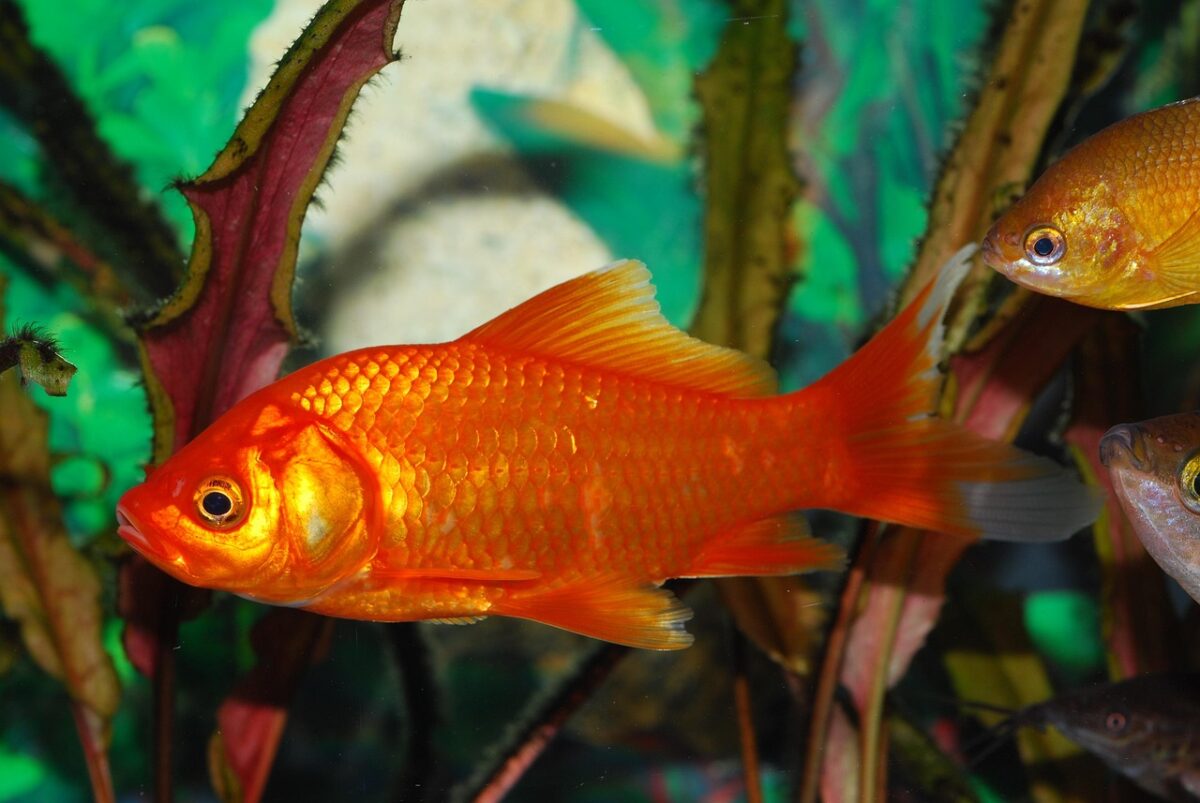
- Scientific Name: Carassius auratus
- Adult Size: 10–12 inches
- Care Level: Easy
- Origin: China (domesticated carp lineage)
- Compatible With: Comet, Shubunkin, and Wakin Goldfish
Pros
- Peaceful and social; thrive in groups
- Identical temperature and diet needs
- Excellent for ponds or large tanks
Cons
- Heavy waste producers; require powerful filtration
- Can accidentally bump or chase slower species
Pro Tip: Keep tanks long and shallow — not tall — to allow active swimming.
Shubunkin Goldfish
Shubunkins are calico-patterned goldfish with long, flowing tails and strong swimming ability. They’re colorful, hardy, and just as tolerant of cool water as Comets.
Their energy levels match perfectly, making them ideal companions for outdoor ponds or large aquariums.
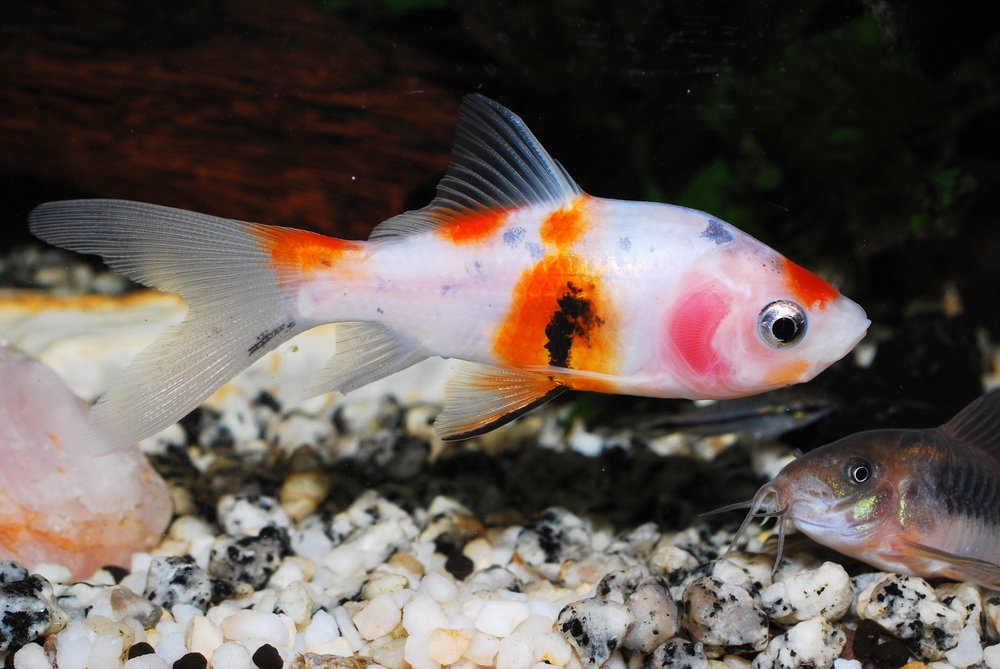
- Scientific Name: Carassius auratus (Shubunkin variety)
- Adult Size: 8–10 inches
- Care Level: Easy
- Origin: Japan
- Compatible With: Comet, Common, and Wakin Goldfish
Pros
- Hardy and adaptable to pond conditions
- Active and playful swimmers
- Adds color variety without sacrificing compatibility
Cons
- May nip fins of slower fancy goldfish
- Need strong filtration due to waste production
Caution: Don’t mix with slow or delicate varieties (like Orandas or Moors).
Wakin Goldfish
Wakin Goldfish combine the sleek body of a Comet with the twin-tail shape of a fancy goldfish. They’re quick, calm, and temperature-tolerant, making them one of the most balanced Comet Goldfish tank mates.
Wakins prefer large tanks or ponds and stand out for their red-and-white coloration.
- Scientific Name: Carassius auratus (Wakin variety)
- Adult Size: 10–12 inches
- Care Level: Easy
- Origin: Japan
- Compatible With: Comet, Shubunkin, and Common Goldfish
Pros
- Peaceful, strong swimmer
- Striking coloration and durable fins
- Excellent choice for pond communities
Cons
- Slightly rarer in stores than Common or Shubunkin types
- Require just as much space and filtration as Comets
Best For: Experienced goldfish keepers or pond owners.
2. Good Companions: 3 Cold-Water Schooling Fish
These fast-moving schooling fish make lively, low-maintenance additions to Comet Goldfish tanks or ponds. They help diffuse aggression, add color to the upper and middle water levels, and handle the same cool temperatures without stress.
Just make sure your tank is spacious and well-filtered — crowding increases competition for food and oxygen.
| Species | Temperature Range | Size | Compatibility | Notes |
|---|---|---|---|---|
| White Cloud Mountain Minnow | 64–72°F | 1.5 in | 4/5 | Peaceful and hardy; best in groups of 6+ |
| Zebra Danio | 65–75°F | 2 in | 3/5 | Energetic; may chase fins if understocked |
| Rosy Barb | 64–74°F | 4–6 in | 4/5 | Schooling fish that thrive in cooler tanks |
White Cloud Mountain Minnows
White Clouds are one of the few small fish that can truly thrive with goldfish. Hardy, peaceful, and perfectly happy in 64–72°F water, they school beautifully near the mid and upper levels of the tank.
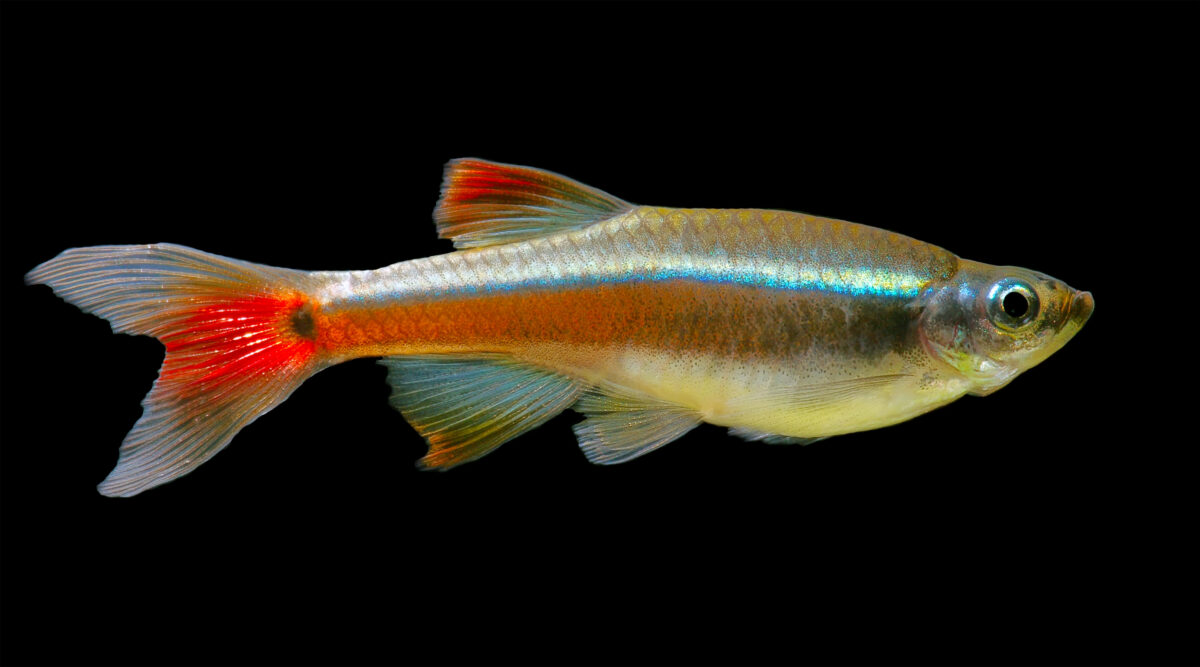
- Scientific Name: Tanichthys albonubes
- Adult Size: 1.5 inches
- Care Level: Easy
- Origin: China and Vietnam
- Compatible With: Comets, Common Goldfish, Zebra Danios
Pros
- Peaceful, cold-tolerant, and low-maintenance
- Adds color and motion to upper water levels
- Excellent starter species for community tanks
Cons
- May be eaten by adult goldfish in smaller tanks
- Needs a tight lid — agile jumpers when startled
Pro Tip: Add floating plants to give minnows shelter and reduce chase behavior.
Zebra Danios
Zebra Danios are energetic swimmers that bring constant movement to any setup. They tolerate a wide temperature range and are extremely hardy — ideal for beginner goldfish owners.
Their speed helps them avoid accidental nips from curious Comets.
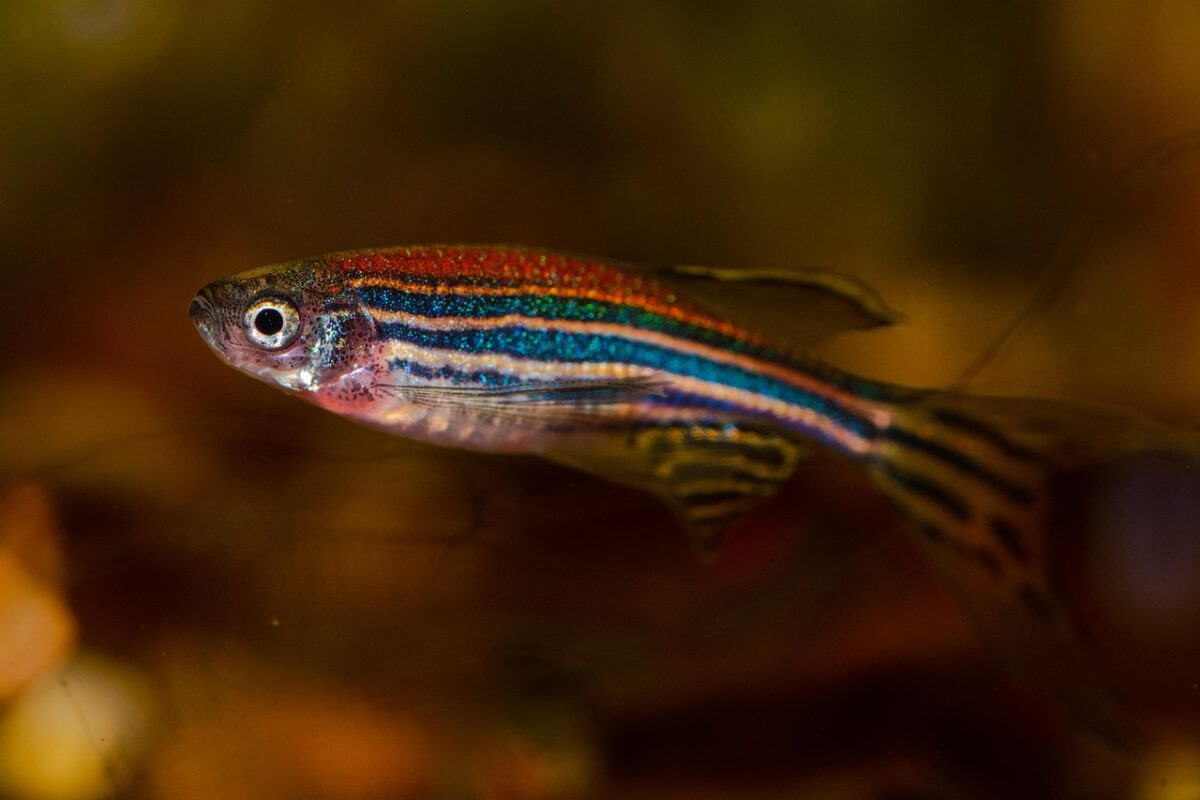
- Scientific Name: Danio rerio
- Adult Size: 2 inches
- Care Level: Easy
- Origin: South Asia
- Compatible With: Goldfish, White Clouds, Rosy Barbs, Tetras
Pros
- Active, playful, and social
- Thrive in the same temperature and pH range as goldfish
- Great for keeping goldfish entertained
Cons
- Fin-nipping possible if kept in small groups
- Need open swimming space to prevent stress
Caution: Avoid long-finned varieties — their trailing fins can tempt curious Comets.
Rosy Barbs
Rosy Barbs are bold, colorful fish that can match a Comet’s pace and temperament. They prefer cooler water and grow up to 6 inches long, making them large enough to avoid being mistaken for food.
Keep them in groups of 5 or more to minimize fin-nipping.
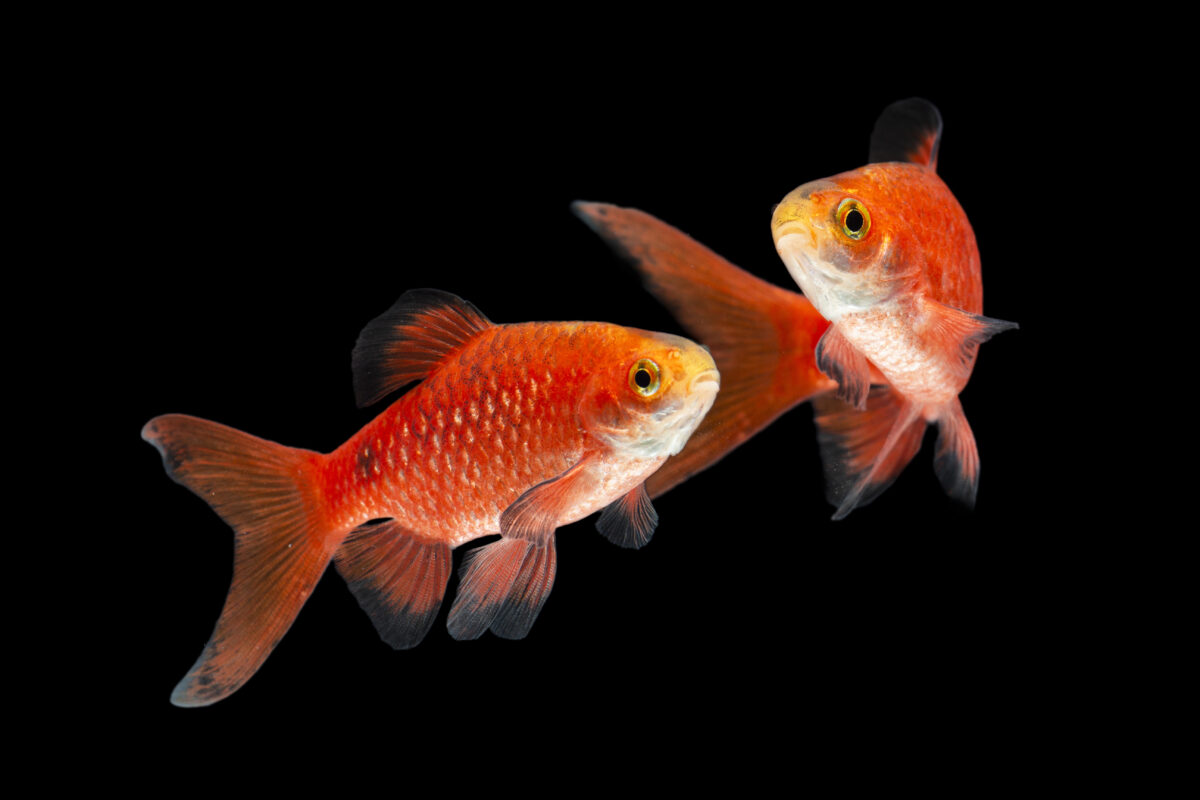
- Scientific Name: Pethia conchonius
- Adult Size: 4–6 inches
- Care Level: Moderate
- Origin: South Asia
- Compatible With: Goldfish, Danios, Weather Loaches
Pros
- Bright, eye-catching color
- Active and hardy in cool water
- Helps maintain social balance in large tanks
Cons
- Can nip fins if understocked or crowded
- Requires strong filtration and oxygenation
Pro Tip: Mix males and females to reduce aggression and balance schooling behavior.
3. Helpful But Limited: 3 Bottom Dwellers & Clean-Up Crew
Bottom dwellers can coexist peacefully with Comet Goldfish, as long as your tank is large enough and well-oxygenated. These species help manage leftover food and algae, reducing maintenance while keeping the aquarium clean.
| Species | Temperature Range | Size | Compatibility | Notes |
|---|---|---|---|---|
| Dojo Loach (Weather Loach) | 64–75°F (18–24°C) | 8–12 in | 5/5 | Social bottom dweller; excellent companion for goldfish |
| Bristlenose Pleco | 68–74°F | 4–6 in | 4/5 | Hardy algae eater; low aggression |
| Peppered Corydoras | 68–74°F | 2–3 in | 3/5 | Peaceful scavenger; best in small groups |
Dojo Loach (Weather Loach)
Also known as the Weather Loach or Pond Loach, this bottom-dwelling species is one of the best cool-water companions for goldfish. It helps clean up uneaten food and adds fascinating behavior to the tank — often “dancing” or swimming actively when barometric pressure changes.
Watch it: This clip shows how friendly Dojo Loaches can be — some even rest calmly in their owner’s hand!
- Scientific Name: Misgurnus anguillicaudatus
- Adult Size: 8–12 inches
- Care Level: Easy
- Origin: East Asia
- Compatible With: All cold-water goldfish and barbs
Pros
- Peaceful scavenger that helps with clean-up
- Extremely hardy and adaptable
- Temperature range perfectly matches Comets
Cons
- May uproot plants while burrowing
Best For: Large tanks or ponds with smooth gravel substrate. Keep at least two — they’re social and prefer company.
Bristlenose Pleco
One of the only pleco species suited for cooler water, the Bristlenose Pleco is a hard-working algae eater that stays under six inches long. It’s peaceful, hardy, and thrives in goldfish tanks with driftwood and hiding caves.
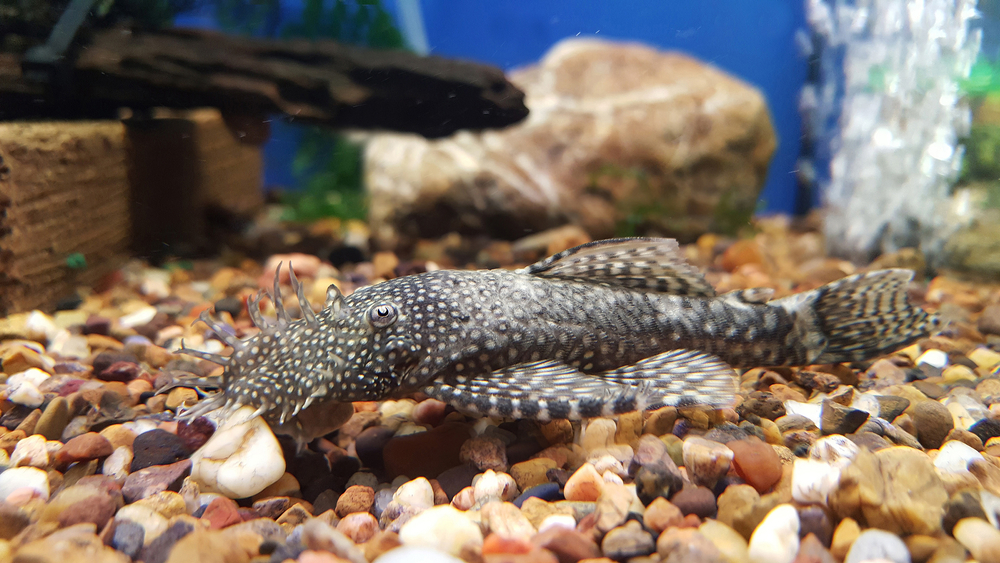
- Scientific Name: Ancistrus cirrhosus
- Adult Size: 4–6 inches
- Care Level: Easy
- Origin: South America
- Compatible With: Comets, Common Goldfish, Corydoras
Pros
- Excellent algae control
- Calm temperament and sturdy body
- Tolerates mild current and cool water
Cons
- Produces significant waste
- Sensitive to low oxygen and ammonia spikes
Pro Tip: Choose a pleco species that stays under 6 inches — large varieties like the Common Pleco quickly outgrow goldfish tanks.
Peppered Corydoras
Unlike most tropical Corydoras, the Peppered Cory is a cool-water-tolerant variety that coexists peacefully with goldfish. They stay near the bottom, gently sifting sand for leftover food.
Keep them in small groups of at least three for natural behavior.

- Scientific Name: Corydoras paleatus
- Adult Size: 2.5 inches
- Care Level: Moderate
- Origin: South America (temperate zones of Argentina and Uruguay)
- Compatible With: Goldfish, small barbs, peaceful loaches
Pros
- Active and friendly; fun to watch in groups
- Helps prevent uneaten food buildup
- Cold-tolerant down to 68°F
Cons
- Sensitive to poor water quality
- Can’t compete with larger, faster fish for food
Pro Tip: Use smooth sand or fine gravel to protect their delicate barbels.
Feeding Strategy For Mixed Tanks
When Comet Goldfish share space with other species, feeding time can turn chaotic. Their speed, curiosity, and bottomless appetites often make them the first to reach every pellet.
A few smart adjustments can keep the peace and ensure everyone gets a fair meal.
- Use a mix of floating and sinking foods. A combination prevents competition and ensures that slow eaters do not go hungry.
- Spread food across the tank or pond. This breaks up crowding and helps reduce aggression during feeding.
- Focus on plant-based nutrition. Choose high-fiber pellets or flakes with spirulina, peas, or spinach to improve digestion and water quality.
- Clean up uneaten food quickly. Leftovers spike ammonia and cloud the water — a serious problem in goldfish setups.
Common Mismatches (Don’t Fall For These Combos)
Even peaceful fish can make terrible Comet Goldfish tank mates. The problem isn’t aggression; it’s lifestyle differences.
When these species mix, it usually ends in stress, damaged fins, or the occasional disappearance of a tankmate.
| Species | Why It Fails |
|---|---|
| Fancy Goldfish (Oranda, Fantail, Ryukin) | Too slow to compete; prone to fin nipping and food stress |
| Betta Fish | Aggressive, tropical, and territorial — easily stressed by goldfish activity |
| Guppies | Too small, easily outcompeted, and often eaten |
| Tropical Livebearers (Mollies, Platies, Swordtails) | Warm-water fish that struggle below 72°F and produce incompatible bioloads |
Quick Takeaway: Tropical fish may survive for a while in cooler tanks, but they won’t thrive. Stick with true cold-water companions — sleek-bodied goldfish, danios, and weather loaches — for a healthy, long-term setup.
Pond Companions For Comet Goldfish
Comet Goldfish were initially bred for ponds, and their size, stamina, and affinity for open water make them ideal for outdoor use. In a well-filtered pond with plenty of depth and oxygen, they can coexist peacefully with other hardy, cold-water species.
Choose companions that match the Comet’s temperature range and energy level — not tropical fish that need heaters or small species that risk becoming lunch.
| Species | Temperature Range | Size | Compatibility | Notes |
|---|---|---|---|---|
| Koi Fish | 65–75°F | 24–36 in | 4/5 | Great for ponds only; require heavy filtration |
| Shubunkin Goldfish | 65–75°F | 8–10 in | 5/5 | Hardy, colorful, and fast-swimming |
| Wakin Goldfish | 65–75°F | 10–12 in | 5/5 | Calm and temperature compatible |
| Weather Loach (Dojo Loach) | 65–75°F | 8–12 in | 5/5 | Social bottom dweller; thrives in ponds |
| Golden Orfe | 60–75°F | 16–18 in | 4/5 | Active schooling fish for large ponds |
Koi Fish
Koi and Comet Goldfish are natural pond partners. Both are peaceful, cold-water fish that share similar diets and behavior. Their bright colors and constant motion create a dynamic display.
However, Koi grow up to 3 feet long and produce a massive amount of waste, so they require a minimum pond volume of 250 gallons per adult and powerful filtration.
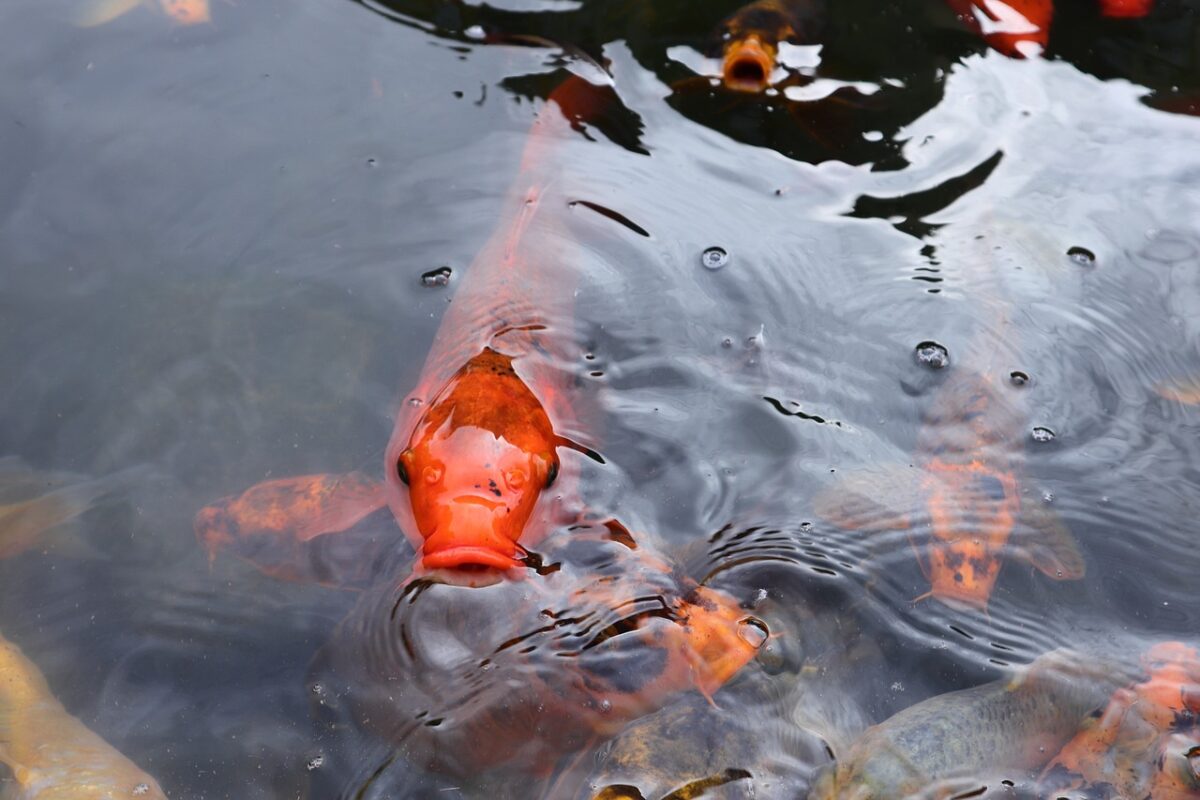
- Pros: Peaceful, visually stunning, cold-tolerant
- Cons: Too large for tanks; can outcompete smaller goldfish for food
- Best For: Deep ponds with strong filtration and ample swimming space
Caution: Never mix Koi and goldfish in small indoor aquariums — even young Koi quickly outgrow them.
Shubunkin & Wakin Goldfish
Both Shubunkin and Wakin Goldfish thrive in ponds alongside Comets. Their streamlined bodies and fast swimming styles make them well-suited for open water, while their bright coloration creates a lively and social group.
Shubunkins are calico-patterned with speckles of blue, red, and black, while Wakins feature striking red-and-white bodies and forked tails. Both tolerate mild winters if the pond doesn’t freeze completely.
- Pros: Hardy, social, temperature compatible
- Cons: Produce high bioload; require regular filter cleaning
- Best For: Medium-to-large ponds (300+ gallons) with aeration
Pro Tip: Combine at least three varieties of single-tail goldfish for a visually balanced pond that stays active and harmonious year-round.
Weather Loach (Dojo Loach)
The Dojo Loach is a peaceful, social scavenger that helps keep pond bottoms clean. They spend most of their time exploring the substrate or resting near the edges and can even signal weather changes by becoming more active before storms.
- Pros: Cold-tolerant, playful, gentle temperament
- Cons: Can burrow and displace small plants
- Best For: Ponds with smooth gravel or sandy bottoms
Fun Fact: Often called the “dog of the fish world,” Weather Loaches are curious, interactive, and even learn to recognize their owners. Many will swim up to the surface to be hand-fed or gently touched.
Golden Orfe
Golden Orfe are sleek, fast-swimming fish that prefer cooler water and plenty of oxygen. They school in groups and add constant motion to large ponds. Because they can grow over a foot long, they need open space and strong aeration.

- Pros: Peaceful, striking coloration, highly active
- Cons: Sensitive to poor water quality; needs ample depth and circulation
- Best For: Large, well-aerated ponds (500+ gallons)
Caution: Keep in groups of at least three — solitary Orfe become shy and less active.
Pond Setup Tips For Goldfish Communities
- Depth: Minimum 24 inches to maintain stable temperature year-round.
- Filtration: Use a pond filter rated for double your pond’s volume.
- Shade & Plants: Water lilies or floating plants help control algae and protect fish from heat.
- Winter Care: In cold climates, use a pond de-icer or aerator to keep a small hole in the ice for gas exchange.
Quick Takeaway: A thriving goldfish pond isn’t just about fish compatibility — it’s about balance. Stable temperatures, oxygen, and filtration are the key factors that enable these cool-water communities to thrive.
Frequently Asked Questions
Even with the proper setup, many aquarists have questions about how to keep Comet Goldfish happy in shared environments. From feeding and water temperature to tank size and compatible species, here are the answers to the most frequently asked questions by hobbyists.
Don’t see your question? Respond in the comments to get the answer you need!
Can Tropical Fish Be Comet Goldfish Tank Mates?
Not long-term. Comets are cold-water fish that prefer 65–74°F (18–23°C), while tropical fish need 75°F or higher. Keeping them together forces one species to live outside its comfort zone, leading to stress, illness, and shortened lifespan.
If you prefer variety, consider other cold-water fish as Comet Goldfish tank mates, such as Danios, White Clouds, or Weather Loaches.
Why Do My Comet Goldfish Chase Other Fish?
Goldfish chasing behavior can have several meanings. During breeding season (usually spring), males often chase females as part of courtship.
But if chasing happens year-round, it can indicate crowding, poor water quality, or food competition. Ensure your tank has sufficient space — at least 55 gallons for one Comet — and provide multiple feeding areas to minimize stress.
Can Snails Or Shrimp Be Comet Goldfish Tank Mates?
It depends on the species and tank setup.
Goldfish are curious and may nibble or eat small invertebrates, especially shrimp. However, large mystery snails or nerite snails can coexist safely in most goldfish tanks and help control algae.
Avoid delicate shrimp species like Cherry or Amano shrimp; they’re more likely to become snacks than tank mates.
How Many Comet Goldfish Can Live Together?
Comet Goldfish grow rapidly and produce a significant amount of waste, making space a critical consideration. You’ll need at least 55 gallons for the first fish and 30 additional gallons per goldfish.
In ponds, aim for a total volume of 250 gallons or more and strong filtration. Crowding is the #1 cause of poor water quality and stunted growth in goldfish.
Can Fancy Goldfish Be Comet Goldfish Tank Mates?
It’s not ideal. Fancy goldfish are slow swimmers with delicate fins. Comets are faster, more energetic, and tend to outcompete them for food — sometimes nipping fins unintentionally.
Do Comet Goldfish Need A Filter Or Heater?
Yes to the filter, no to the heater. Comets are cold-water fish, so you don’t need a heater unless your home drops below 60°F regularly.
A high-capacity filter is essential. Goldfish are messy eaters that produce a heavy bioload. Select a filter rated for at least twice the volume of your tank.
Can Comet Goldfish Live With Koi Indoors?
No. Koi are pond fish that can grow over 2 feet long and produce enormous waste. They thrive in outdoor ponds with vigorous aeration and large water volume.
Comets and Koi can live together in ponds, but not in aquariums. Even juvenile Koi will quickly outgrow most indoor setups.
Building A Peaceful Goldfish Community
Creating harmony in a mixed aquarium takes planning, patience, and the right companions. Once your Comet Goldfish are thriving, you might want to explore other species and setups that bring your tank to life.
Continue your aquatic journey:
Whether you’re planning a serene pond or a bustling indoor tank, success starts with compatible species, clean water, and a little observation every day.

